#viking animation studios
Explore tagged Tumblr posts
Photo

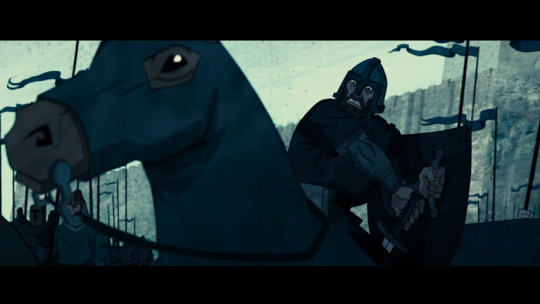
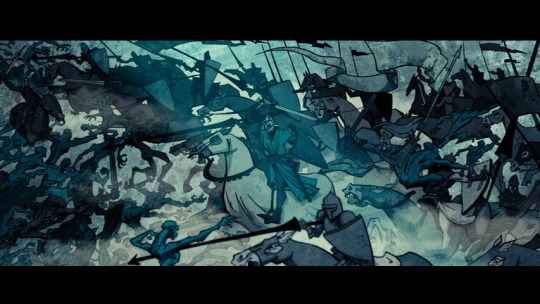




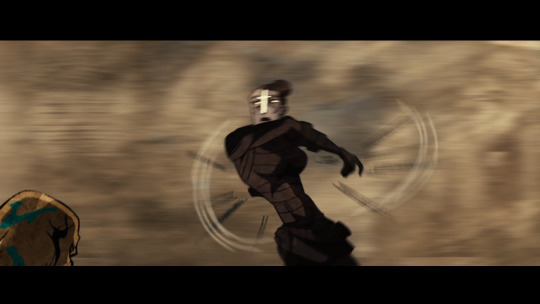
Can we just talk about how AWESOME Genndy Tartakovsky’s prologue in Priest (2011) is? Beautifully animated by Cathy Jones (All Dogs Go to Heaven 2, Sym-Bionic Titan, Sofia the First), storyboarded by Bryan Andrews (Star Wars: Clone Wars, The Powerpuff Girls), and designed by Genndy himself at Viking Animation Studios.
When you can’t do animated opening credits, you can try animated prologues. (tweet)
Tweet version here.
PROLOGUE ANIMATION BY VIKING ANIMATION STUDIOS
DESIGNED BY GENNDY TARTAKOVSKY
PRODUCER: SHAREENA CARLSON
STORYBOARD BY BRYAN ANDREWS
BACKGROUND DESIGN: Justin K. Thompson (as MICHAEL KENT THOMPSON) @shinypinkbottle
BACKGROUND COLOR: DAVE BLEICH @dbleich
ANIMATOR: CATHY JONES
#priest#priest 2011#priest (2011)#genndy tartakovsky#bryan andrews#cathy jones#viking animation studios#prologue animation#vampire#vampires#vampire hunter#vampire hunters#action#animation#cartoon#cartoons#justin k thompson#justin k. thompson#justin thompson#michael kent thompson#dave bleich
28 notes
·
View notes
Text

gotta represent my mash potato language and viking raid roots
#hetalia#denmark#hetalia nordics#aph nordics#viking#hetalia denmark#anime#fanart#hetalia fanart#anime fanart#sketch#doodle#clip studio paint#my art
92 notes
·
View notes
Text












Studien und Short-Commissions. :3
#art#illustration#studies#anime#anime art#artists on tumblr#digital art#clip studio paint#csp#black cat#fox girl#catgirl#viking#doggo
65 notes
·
View notes
Text




IT'S HERE !!
Farmland arc I'm readyyy
Vinland Saga Season 2 Episode 1
#anime#art#best anime#anime quotes#anime scenery#anime screenshot#manga#thorfinn#askeladd#vikings#einar#vinland saga#vinland saga season 2#mappa#studio mappa
50 notes
·
View notes
Text
It's been a while since I've ugly-cried over a character. And no, he's not dead.


7 notes
·
View notes
Text
Saga Anderson, and Nordic rep in Alan Wake 2
Early on in Saga Anderson’s exploration in Alan Wake 2, she runs into Ilmo Koskela. Fiercely proud of his Finnish heritage, Ilmo gregariously makes note of Saga’s Nordic sounding name and the familiar design of her knitted sweater. Perhaps a fellow Finn?
Alas no, Saga’s mom is Swedish she informs him. Immediately Ilmo’s face falls. I’m not sure if it’s actually just the animated character defaulting to his resting face, but either way the timing is too perfect. Cue uproarious laughter from me. People in the Nordics are on friendly terms of course, but we gotta have the tiniest bit of… scornfor each other. All in good fun of course. It’s traditional.
Now, I’m Danish, not Finnish, but still, I feel right at home in the towns of Bright Falls and Watery in Alan Wake 2. All of the little nods to Nordic culture and mindset feel so wonderfully familiar to me. The melancholia, the irreverent sense of humor, the affection for the Finnish and Swedish quirks of the characters. The game feels all the stronger in tone and narrative for Remedy embracing the Finnish roots of the studio.
Which is exactly why it sucks that I almost immediately saw the charm of those narrative decisions weaponised against Saga.
I first watched the scene between Ilmo and Saga on a lets play when I was trying to figure out if I should finally dip my toes into survival horror and buy the game. Delighted by the writing I took a look into the comments to see if people were vibing as hard with it as I was. They were. But I also saw a comment that made me frown.
Paraphrasing, it basically went, come on, like hell a guy like Ilmo would make the assumption that a black woman is Finnish. There are a multitude of reasons why I think that person was wrong, mainly that Nordic people love it when we run into each other in other countries, but it also just made me sad.
Saga being black does not negate her Swedish heritage. Formally, she is American, sure (I assume, not sure how that works in the US), but she’s raised by her single Swedish mom, of course she’s going to identify heavily with that part of her herself. It’s a profound and essential part of who she is.
But hey, I’m a white potato Dane, so I’m not gonna argue that I know much about the experience of being biracial. I’m gonna stick to what I know, which is that Saga is a very moving and beautiful example of something that I’m actually not used to seeing much of - a story about connecting with your Nordic heritage and roots. And it’s part of why I love her so much.
When Nordic people show up in big, international productions, it’s usually as Vikings, and sure, it’s fun to see our wild ancestors, but contemporary questions of Nordic identity and heritage is not something I often see explored. Not even in our own productions.
So much of Saga’s story is about family. Fighting for her current one, Logan and Casey (and sure, David too, lol), and rediscovering her first one. Tor and Odin.
Her discovering her ties to Tor and Odin is profoundly moving and made me teary-eyed several times over. And sure, a lot of those ties are fantastical in nature, but they still feel very much grounded - and what makes us Nordic if not the ties to our myths and legends that Tor and Odin have made themselves the living avatars of.
While Saga’s mom, Freya, had good reasons for leaving the Anderson seer magics behind, seeing them as part of what made her family fucked up, she also cut Saga off from the fullness of her capabilities. It is only through Saga reforming her family, healing its scars and fully embracing the Anderson heritage that she becomes as powerful a parautilitarian as she is at the end of the game. That’s beautiful.
And in fact I think Saga being black only deepens the richness of those themes rather than negate them or make them irrelevant. Because yes, Saga’s story would have been moving if she was a white character too, but I am very well aware that a lot of biracial people of Nordic ancestry can feel alienated from that part of themselves. Not least because questions of who gets to claim a Nordic heritage can get pretty ugly around here. There are most definitely people who share the racist mindset of that commentator. It adds an extra dimension. Which is why seeing Tor and Odin’s eagerness to claim Saga as part of the Anderson heritage is all the more moving. Through her magics, she’s just so obviously an Anderson, and they’re so damn proud to call her theirs and fight alongside her. Because they all got that wild Viking blood in them. They’re part of her and she’s part of them.
Roger Ebert, the film critic once called movies empathy machines. I think games, when they’re at their best, can be an even more intense variation of that. Which is exactly why it baffles me that some people can play through Alan Wake 2 and still think Saga is a stunt-woke character rather than someone fully and beautifully integrated in the narrative. A narrative which, at its most basic level – in my opinion – is about the mystical bonds we form with each other and the rest of the world through art and love and blood and family and heritage. All the great horror doesn’t negate that either, it amplifies it. Kind of like that clicker.
#I really didn’t mean to write like… a fucking essay#so this is probably gonna flop#but I love Saga so much#and as a Scandinavian woman#I feel so seen by her#and I hate that people are being so vile about her character#Saga Anderson#Alan Wake 2
108 notes
·
View notes
Text
Saw the trailer for the live-action How To Train Your Dragon…
…thanks, Dreamworks! I fucking hate it!
Okay, but real talk:
How To Train Your Dragon is a franchise near and dear to my heart. It was the very first fandom that I went full in on as far as engagement goes: saving fan art, reading fanfics, getting into fandom fights, interacting with fandom hierarchy (and hating the users who carried themselves like leaders of the fandom), rooting for the movies to win awards, keeping my eye out for every new piece of content, watching each season release of Race To The Edge like my life depended on it, etc. Whenever anything HYTYD-related was coming up, I was on it like a hawk!
I fell out of the fandom some time around the release of the third movie; I think I had started college then and got swamped with real life stuff, so much so that I stopped using Tumblr almost entirely. In addition, a lot of my favorite users left the fandom and/or stopped using Tumblr, so there wasn’t the same sense of community and interest as before.
I haven’t touched HTTYD material since, but it’s still dear to my heart. So when I heard that there was a live action remake coming…
…I was annoyed as shit.
I absolutely DETEST the current Hollywood trend of live action remakes. I hate the implication that all IPs must tend towards live action, that an animated IP can’t be seen as whole and complete on its own and must ‘graduate’ to live action in order to be fully respected, that live action is somehow superior to animation, and most importantly, that studio execs feel the need to make these remakes so grim and serious and Game of Thrones-like. I hate the remakes when Disney does them, I hate the remakes when Paramount does them, and I hate that Dreamworks is now hopping in on the trend.
The trailer/live action medium makes Berk and the Vikings look incredibly dull, grey, and boring. There’s no color, no vividness, no energy, no charm, no pizzazz, nada. Everything looks like it’s had the life sucked out of it. I know I can’t judge acting from a mere trailer, but it already looks mid as hell. I’m black myself, so I don’t get too up in arms about race swaps, but I’m also a huge stickler for detail, and I like it when the characters match up 1 to 1. I personally don’t consider race swaps to be a fulfilling form of representation, so remakes where a white character gets swapped out for a girl of color don’t do anything for me.
And Toothless’s animation…oh my goodness. If they were just going to replicate his appearance from the animation, then why the fuck did they even bother? Like what even is the point?
I’m sorry that I sound hateful, but wow, I hate this! They should’ve just made a new series! Maybe a prequel with the gang’s parents, or featured another tribe in the world of Berk, or done an AU—anything but more live action schlop!
#httyd#how to train your dragon#httyd2#how to train your dragon 2#httyd3#how to train you dragon: the hidden world#hiccup haddock#astrid hofferson#stoick the vast#toothless#snotlout jorgenson#httyd hiccup#httyd astrid#httyd snotlout#httyd stoick#hiccstrid
31 notes
·
View notes
Text


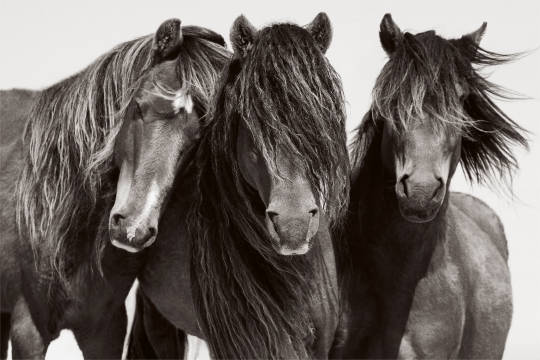
In the middle of the North Atlantic Ocean, about 100 miles from the Canadian province of Nova Scotia, there’s a small sliver of land that is populated entirely by wild horses.
These horses — about 450 of them — are the only full-time residents of Sable Island.
“There’s really nowhere else like it on Earth, and it’s one of those places that I think very easily puts you into perspective about our place in this world,” said Drew Doggett, a photographer and filmmaker who has been visiting the Canadian island for more than 10 years. “You’re on this teeny-tiny speck of sand in the middle of the North Atlantic, and you’ve never felt so small. Yet you’re amongst these animals that are thriving in this place that is nothing but sand and dune grasses and a few freshwater ponds.”
Canada’s Sable Island is home to hundreds of wild horses. No other species lives there year-round.
For more than 250 years, horses have been living on the remote, crescent-shaped island, which has a land area of just 13 square miles.
They’re one of the remarkable breeds Doggett photographed for his new coffee-table book “Untamed Spirits: Horses from Around the World.” His images celebrate the beauty and enduring appeal of horses by documenting some of the most exceptional on Earth.
“Their stories of survival and ability to thrive in these places — places that man oftentimes has not been able to — it’s awe-inspiring,” he said.

An Icelandic horse traverses a black sand beach. Iceland is “home to these extraordinary natural features that almost defy reality,” Doggett said.
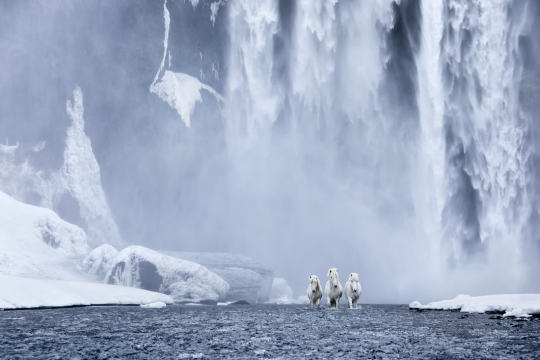

Some of Doggett’s most striking photos came out of Iceland, which is home to a rugged breed descended from the original Viking horse.
“They live a very surreal and otherworldly existence,” Doggett said. “There are some pretty remarkable geological features, from black sand beaches to dramatic waterfalls, that I wanted to photograph these horses amongst.”
The photos look like something out of a fairy tale or a fantasy novel, artfully shot in front of Iceland’s stunning backdrop.
“They’ve created their own fortune in this really difficult, yet beautiful land, and that’s something that attracted me to their story,” Doggett said.
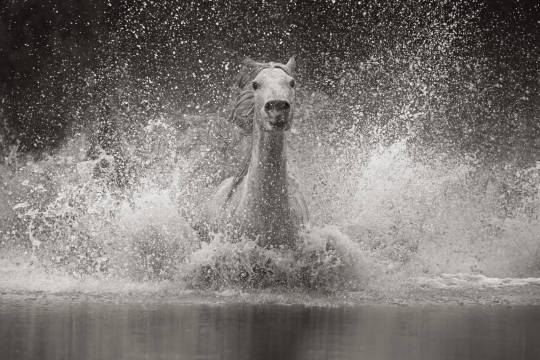
Another breed that Doggett features in his book are the white horses of Camargue. This ancient breed is native to a remote, marshy area in the south of France, where it has roamed for centuries.
“Large, dark, expressive eyes and a palpable, innate confidence punctuate the raw, bold beauty of the Camargue horses,” Doggett says in his book. “They move swiftly, without hesitation, and charge through the water in the natural hierarchy that inevitably arises within their ranks.”
These horses are semi-wild, protected by herdsmen known as gardians, or “the cowboys of the Riviera.”
“There’s been cave paintings discovered in this region of these horses, (from) probably prehistoric times,” Doggett said. “So there’s this lineage that was fascinating.”

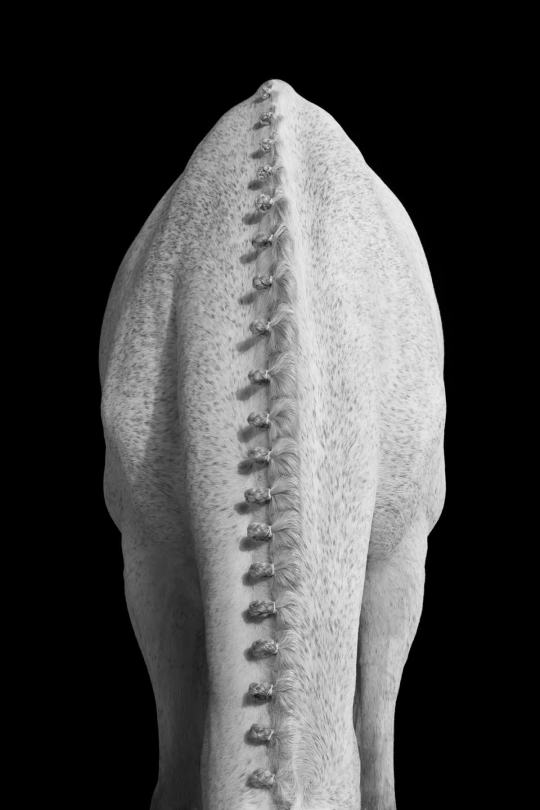
Doggett set up a studio in Florida to take portraits of sport horses.

“I find it fascinating when wild animals have a similar domesticated counterpart,” Doggett said.
Wild breeds were Doggett’s initial fixation when he started this project, but his book also includes portraits of world-class sport horses from the equestrian world.
He set up a mobile studio in barns in Wellington, Florida, and drew on his background in fashion photography.
“I was focusing on the musculature of these horses almost as if they’re kind of carved from marble, and I was using studio lights, almost painting them with light,” he said. “I really enjoyed being able to hone in and focus on — in a very intensive way — the physical attributes of these elite animals.”

When Doggett wanted to do a series of images showing this musculature in motion, he went to the Caribbean and photographed horses swimming in the crystalline waters off the island of Tobago. He linked up with a nonprofit rescue group that cared for retired racehorses, polo horses and show jumpers.
“As their daily exercise, the owners of the nonprofit would swim them off the waters of the beach in Tobago,” he said. “This is part of their everyday existence.”
Doggett would put on scuba gear and take photos below the water’s surface — difficult, he said, but extremely rewarding.
“I felt like underwater was a way which I could highlight these animals’ elegance and grace in a minimalist backdrop,” he said.
Across all of his different photo shoots, Doggett felt there was a common theme among the horses — an untamed spirit that inspired the title of his book.
“Whether they’re domesticated or not, their wildness never truly disappears,” he said. “They also represent strength, resilience, courage, endurance — all these various qualities that I am drawn to and want to celebrate.”

“They represent a certain mythological and symbolic-like ideology that doesn’t really exist in other animals,” he said. “They’re respected and honored symbols around the world. …
“I think there’s something incredibly romantic about the notion that there are these animals out there which exist that are so strong and courageous yet their wildness can’t ever be tamed.”
Drew Doggett’s book “Untamed Spirits: Horses from Around the World,” published by teNeues, is now available.
35 notes
·
View notes
Note
People are saying why are racists commenting on the live action of How to train your dragon because they race swapped a female lead.
It's always the same comments "it's a fantasy movie, chill" "stop hating on the characters". Well dear Karen i wouldn't mind if Disney wasn't so obviously greedy. They defend a corporation αν είναι δυνατόν-
The movies are supposed to be about Vikings myths so of course all the characters in the original animation looked like Vikings. They think people are hating on the actors? No the studios are the problem 😭
Same with the Witcher on Netflix. In which the series was based on a POLISH BOOK. And guess what? Zero Polands and the material was ruined to make it the next Game of thrones.
Some things like dragons and monsters existed and meant something to these cultures, but of course they always think progress is more skin colour than cultural heritage.
I don’t know what other ways I can come up to explain to them that I and all who agree would 100000 times over watch a show taking place in Africa with African characters about African heritage than one about a race bent Viking in which Nordic culture becomes like a pop culture pie anyone can take a piece from because ✨visibility✨🤡
Visibility is showing the heritage of those who are neglected and showing heritage accurately.
(Also you gotta love them calling everyone racist when they are almost certainly the ones who spend the most time thinking about skin colour globally. Fellows do I have news for you )
Another thing, many of these projects that based on the plot would need white / white-passing actors inexplicably race bend one character and the rest remain accurate. What does this tell you? That creators only do this to be “approved” and play the “look I got the diversity too!” card and not because this is the way they envision their work. Otherwise, they would have a cast where everyone is diverse, people from all the parts of the world, and not 20 north European looking actors and one inexplicable African-American, for example.
It’s really so hypocritical, I can’t believe people eat it up…
#representation in media#Nordic#Vikings#not Greece related#per se#anon#mail#Witcher#how to train your dragon#polish representation
18 notes
·
View notes
Note
wow you really love disney metafiction
Well yes Who Framed Roger Rabbit always fascinated me as a kid, what adaptions would our world have what would change if our characters really existed and lived beside us would Disney be as greedy as it is if Mickey Mouse was actually owner over it it instead of Bob Iger being CEO nd Investors having their claws in it? Would Bugs be the owner of Warner or would he be chilling as an A-list celebrity who is a known as a beloved LGBTQA Drag Queen and Genderfluid Veteran?
Mickey and Minnie married off screen and dating on screen?
Looney Tunes known as chaos incarnate but they're a giant family
Bugs and Daffy adopted the Animaniacs because they had no home
Are Bugs and Daffy together off screen?
What would shape each toon into their On Screen and off-screen selves creating that divide?
What would the huge differences be? Maybe some have kids others are married and some have entire seperate family?
How would humans react to these guys as a species that has a bad record of looking down upon people?
Mickey and Bob Iger having a I absolutely despise you but I have to tolerate you relationship
Off screen the Warner siblings are actually related to Oswald and Ortensia explaining the Animaniacs' strange unidentifiable appearances,
Like the possibilities are endless and vast, there's just so much unexplored due to the fact companies can't share at all anymore and they don't think live action hybrids are useful
Chip and Dale 2022 resparked it for me, a lot of ideas going a million miles, like if I had finances I'd be getting reference shots to use for test fan animation just for the fun of it, cause it fascinates me that much,
And while you call it metafiction it's actually just cartoons meeting our reality seriously go check out the movie Who Framed Roger Rabbit that movie right there shows what exactly I'm talking about and here I'll even include some screenshots of a couple films that do this

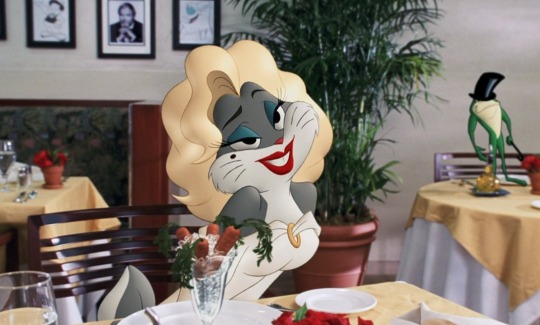
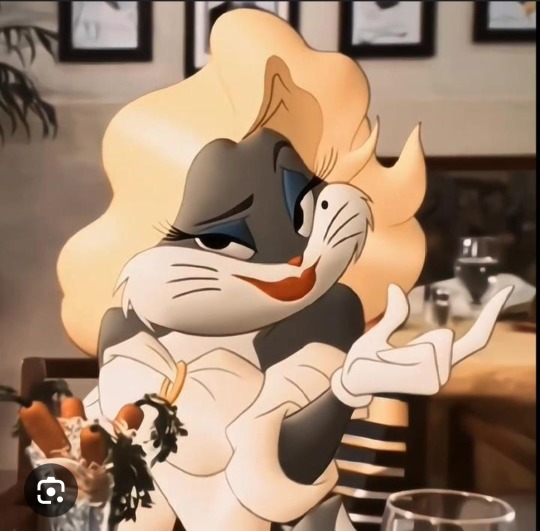
Bugs Bunny Focus for Back in Action cuz honestly I think this is his most iconic look besides the Viking look when it comes to his drag and honestly the line normally I play the love interest is just amazing
Roger and Eddie(played by Bob Hoskins) in Who Framed Roger Rabbit

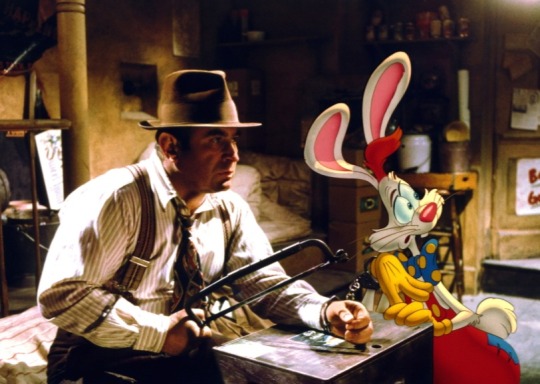
Chip and Dale Rescue Rangers 2022


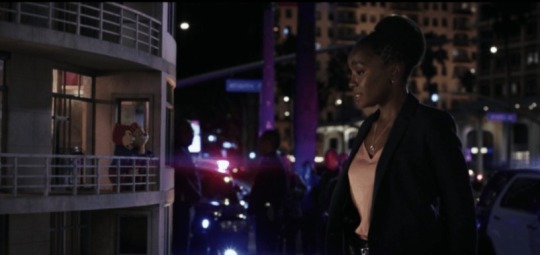
This is the adaption I was talking about earlier look at Ellie next to the apartment building for small toons. She's as tall as it, while Chip and Dale are the perfect size for it, unlike Who Framed Roger rabbit Chip and Dale takes place in the modern day that's what hooked me to create a modern AU it's all so fascinating,

You can't see it in that shot but Dale is driving a full-blown human sized car that has been adapted for Chipmunks I'm not joking, however their movie shows how wildly different everybody can look from each other especially in the modern day when CG is a thing. Chip is still clearly 1990s 2D animated while Dale decided to get a CGI redesign
Like if Mickey and Minnie are only two feet tall and if he's the big boss on set yeah it's really funny to me to imagine him running around Disney and trying to picture every single Studio adapting to these Toons and their various size differences
Again there is just so so much that has been untapped with this genre, because Studios cannot get along long enough to tap into it
#who framed roger rabbit#chip and dale#chip n dale rescue rangers#disney#warner#baffy#Animaniacs#mickey mouse#minnie mouse#oswald the lucky rabbit#yakko warner#bugs bunny#daffy duck#looney toons
48 notes
·
View notes
Text
"I've seen suffering in the darkness. Yet I have seen beauty thrive in the most fragile of places." - History, Culture and Identity in Cartoon Saloon's Irish Mythology Trilogy
Written accounts of Irish history and culture only begin to appear from the 5th century onwards and what came before we are left to piece together from archaeological remains whose meanings and motivations we can only guess at. What is clear, though, is that during that broad stretch of time between the Early Mesolithic and Late Iron Age, a distinctly Irish identity had been established and cultivated through by the craftsmen, artists, hunters, foragers, farmers and warriors that populated the country through their housing, weaponry, metalworks and stone monuments. The development of the Christian church throughout the Early Medieval period brought its own beauty to the art and architecture of the country, but also adapted its culture to suit the needs of an integrating religion and sites and ceremonies of pagan worship were amalgamated into the Christian calendar. Following this were Viking raids, Anglo-Norman settlement, English conquest, plantation, oppression, rebellion, famine and civil war. From the Early Medieval period to the present day Ireland has experienced an almost constant shift in leadership and identity with little time in between for the dust to settle. Culturally, a "Celtic Revival" in the late 19th and early 20th centuries sought to re-invigorate the arts and history of Celtic Ireland (a broad, problematic concept in itself) as an expression of nationalism and to bolster a distinctly Irish artistic and literary identity. All of this is to say that wading through Ireland's history of social upheaval, religious and political conflict, and loss and confusion of identity is no mean feat. To take those threads and conjure up original stories for modern audiences, embracing the suffering and celebrating the beauty, is impressive. To do it three times is witchcraft.
In their films depicting Irish history, culture and mythology, animation studio Cartoon Saloon have approached their stories with a respect for the past, both fact and fiction. By evoking the artwork, legends and real history of Ireland's past and combining it with their own fresh, unique visual style, Cartoon Saloon brings some much needed authenticity and vibrancy to the depiction of Ireland in mainstream culture. Absent are the twee figures of backwards island folk or the commercialised idolatry of a St. Patrick's Day parade. What we get instead is something more personal, recognisable on the surface to every child and adult who learned about Fionn, the Fianna and fairy circles in primary school and with nuggets of information and visual cues for explorers of Ireland's broader history.
"I can't tell you which parts of this story are true and which parts are shrouded by the mists." - The Secret of Kells and the line between history and mythology
Set roughly in the 9th century AD The Secret of Kells is the earliest depiction of Irish culture in the trilogy. This period saw the introduction of Christianity and the eventual integration of the religion among the native Irish, a relatively smooth transition when compared to later events as noted by historian Jo Kerrigan: "And so the people of Ireland combined the new ways with the old…not bothering too much that the names had changed." Although the main character, Brendan, comes from a Christian monastery and carries those beliefs, The Secret of Kells does well to capture this balance between a new religion and old beliefs with the inclusion of Aisling and Crom Cruach, and without dismissing them as a childish or archaic. "Pagans. Crom worshippers. It is with the strength of our walls that they will come to trust the strength of our faith." The threat of Viking raids is what spurs Abbot Ceallach's desire to build a wall around his monastery, but, underlying his actions is another aspect of a monk's work - converting the natives. In The Secret of Kells the abbot's wall not only protects them from invaders but cuts them off from the forest beyond - the domain of shape-shifters, wild animals and pagan temples, a world that Brendan can only glimpse through a crack in the wall. A staple of the entire trilogy is this depiction of wilderness in some form and its association with Ireland's symbolic wilderness and pagan ancestry. When Brendan enters the forest for the first time it is dark and frightening until Aisling, an ethereal Sídhe figure who can shape-shift into a wolf, shows him how to navigate it. Brendan's fear is eliminated and Aisling quickly becomes his friend, each amused and fascinated by the other.
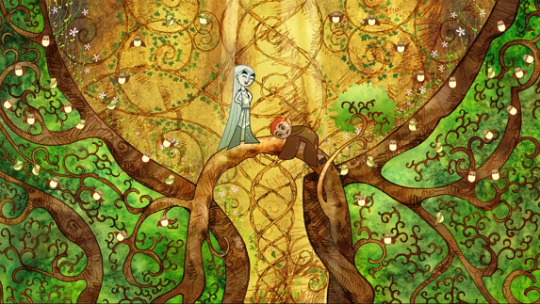
Hidden throughout Brendan's trek in the forest are old, moss covered ogham stones and stone circles, allusions to native practices, but deeper in, the colour palette changes from bright greens and natural browns to a wash of dark greys and black when Brendan stumbles across a temple to Crom Cruach (a deity who, in Irish mythology, is eventually destroyed by St. Patrick). Aisling tries to warn him away, "It is the cave of the Dark One," but Brendan dismisses her worries, "The abbot says that's all pagan nonsense, there's no such thing as Crom Cruach." At the sounding of the deity's name, black tendrils emit from the cave and pull on Aisling as she stops them reaching Brendan. Later, Brendan returns to the cave to steal Crom's eye - a magnifying crystal that will help Brendan and Brother Aidan with their illumination. In a beautifully animated sequence Brendan battles Crom Cruach in his cave by trapping him in a chalk circle and stealing his eye. Crom Cruach is depicted as a never-ending snake (in a geometric pattern reminscent of both pre-Christian art and the knotwork of Christian manuscripts) possibly in reference to the 'snakes' (demons) banished from Ireland by St. Patrick. What's most fascinating about this sequence is that Brendan experiences it at all. Although the experience is supernatural it is never implied as anything other than real. Brendan is a committed monk in training who will spend his life in service to the monastery and creating the Book of Kells; even after meeting Aisling and battling Crom Cruach he never questions his faith or his elders and when he returns to the monastery with the eye no one disputes the story of how he came by it, "You entered one of the Dark One's caves?" At this time, at the edge of a growing monastery and with a direct reference to the abbot's desire to convert the natives, there is still space for pagan ideas to exist. Whenever Brendan is punished by Abbot Ceallach it is for disobedience not a lack of faith. Similarly, Aisling using Pangur Bán's spirit to free Brendan has an effect on the real world. There's an argument to be made that this is a film and anything can happen, but for problems to be solved by magic, the way Aisling frees Brendan, firm world-building rules must be established; in this world, 9th century Ireland, spaces exist in which otherworldly figures reside and actions beyond the mortal realm occur and these spaces exist alongside this film's version of civilisation, the monastery.
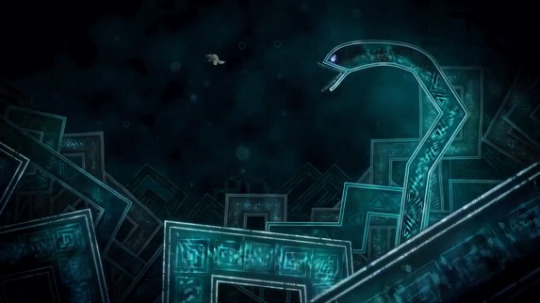
"I have lived through all the ages, through the eyes of salmon, deer and wolf." As an animated feature, there is a lot the film can tell us through visuals alone, and The Secret of Kells does a wonderful job capturing an Ireland in transition. The prologue opens with a close-up image of the Eye of Crom with abstract shapes swimming around it, followed by a glimpse of Aisling hiding in a tree as she narrates over these images in an eery whisper. Following these we see a salmon, deer and wolf, three animals important to Irish mythology, identity and history; the salmon, related to The Salmon of Knowledge, represents mythology, the deer is the national animal of Ireland, and wolves (in the world of Cartoon Saloon) represent its wildernes and history (the elimination of the wolf population became more active in Ireland during times of English occupancy, a theme that is explored more deeply in Wolfwalkers). Even the waves crashing around Iona as Brother Aidan escapes morph into wolves, futhering their symbolism as something wild and dangerous, yet they are never associated with the Viking raiders; the wilderness is as equally affected by change as the people are. The monastery is littered with Iron Age motifs existing alongside Early Christian imagery. Spiral motifs occur in trees and plants, in the ropes that bind the wall's scaffolding together, and circular, semi-circular and zig-zag shapes continue to appear with knot-work patterns and religious figures - even the snowflakes during the raid are strands of knot-work. The monastery itself is accurate to the period with its round tower, beehive shaped structures (called clochán) and the town growing around it, while outside its walls Brendan crosses a stone circle. We even see a game of hurling, the ultimate unifying bridge between pagan and modern Ireland. The walls of the abbot's cell are covered in his own drawings of plans for the monastery's construction. These are exquisitely detailed and clearly a plan for the future but drawn in a style that cannot escape the past; zig-zags, spirals, circles, semi-circles, dots, triangles, sun and star motifs and something that looks like an alignment chart. The style is evocative of the insular La Tène that preceded the arrival of the monks in Ireland; a combination of abstract and geometric, seemingly random, but clearly symbolising something greater.
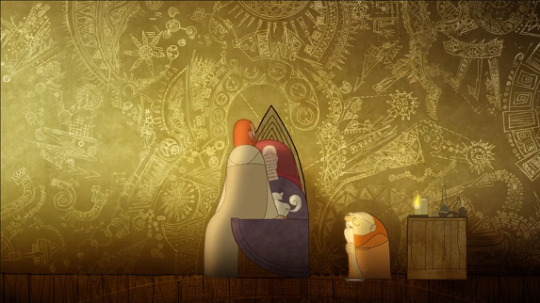
"You must bring the book to the people." In their last interaction as children Aisling helps Brendan recover the pages of his manuscript as he flees the Vikings. In this gesture Aisling aids Brendan on his religious journey - during the montage later on she even guides him home. Faith never comes between these two, their relationship is one of mutual curiosity and sharing their differences. In Irish mythology, female figures (particularly shape-shifting ones) are often symbolic of Ireland itself and to have the support of these figures is, for kings and heroes, a mark of validation. At this time, these two worlds still live alongside each other and Aisling is allowed to support Brendan's work as a monk while maintaining her own natural way of life. Although Brendan's final journey home shows the spread of Christianity across the country we get one final image of Aisling, changed to her human form in a flash of lightning, that shows us she hasn't disappeared just yet. Brendan, now an adult, returns to Kells and although Abbot Ceallach is old and sick, the monastery stands strong and Brendan brings with him the completed Book of Kells, ready to continue the abbot's work.
"This wild land must be civilised" - Wolfwalkers and the taming of Ireland
Set in 1650, Wolfwalkers occurs roughly 800 years after The Secret of Kells and presents a vastly different universe. The monks' Christianisation of the natives was a far more gentle affair and one founded in a desire to educate people. Ireland under the Lord Ruler (a stand-in for Oliver Cromwell) is a world of service, punishment and fear. By chopping down trees and employing hunters to cull the wolf population the Lord Ruler is attempting to 'tame' the countryside and, most importantly, the people themselves. References to "the old king" and "revolt in the south" place us, historically and politically, in the Cromwellian Conquest, when Cromwell was sent to Ireland to quell uprisings against the newly established English Commonwealth. Heavy stuff and this is a simplification of a period of major conflict in Ireland but Wolfwalkers impresses on us the feeling of living under the thumb of an active oppressor on a much smaller, more personal scale. The Lord Ruler wants the people of Kilkenny afraid and complacent so that they support his efforts to cull the wolves and cut down their forests. Although the wolves pose no threat to the city, people have been made to fear them, resilting in the loss of their connection to the forest outside the town walls. Any reference to a world ouside of the current mode of conduct is cause for immediate punishment and suppression. Even Bill and Robyn, loyal English citizens, are punished. When one of the woodcutters talks of "pagan nonsense" he is confined to the stocks and Robyn is forced to work as a maid in the castle when she does the same. When Bill fails to cull the wolf population (and control his own daughter) he is stripped of his rank as hunter and forced into the role of soldier, robbed of the little freedom he had.
"This once wild creature is now tamed, obedient, a mere faithful servant." Although this line is spoken in reference to Moll, held captive in a cage in her wolf form, it is the human characters who suffer the most from this ideology - even the nameless background characters are confined to the walls of the city. What comes to mind when hearing this line is Robyn in her maid's uniform, once lively and imaginative, now returning home with lines under her eyes after a long day of hard, monotonous work, and Bill, shackled at the neck and forced to march behind the Lord Ruler's horse ("we must do what the Lord Ruler commands"). Although Moll is held captive too, it is in the form of a humongous wolf; she is locked away in the Long Hall for fear of the danger she represents because the Lord Ruler is aware of how poweful she is and so he must keep her locked up to show the people of Kilkenny just how much control he can wield, quelling any potential notions of power they might have held in themselves. In the case of Moll, Robyn and Bill, each time they are held captive by the Lord Ruler their captured bodies submit to the wolf form to escape: Moll uses its strength to break free of her chains, Robyn leaves behind her human body to launch an attack against the soldiers with the rest of the pack, and Bill, who had no idea what being bitten by Moll would do to him, submits to a primal instinct within him to protect his daughter and attacks the Lord Ruler. The Wolfwalkers are able to draw on this power but the people left behind in Kilkenny have no such escape.
"What cannot be tamed, must be destroyed." The ending of Wolfwalkers is bittersweet. Robyn, Médb and their parents are safe after defeating the Lord Ruler and his soldiers and ride off, not quite into the sunset, but onto horizons new. "All is well," Bill and Robyn tell each other and the family appear content, but, before now, leaving the forest was not on the agenda; leaving the forest meant retreating from a threat, as Moll desperately wanted Médb to do, and this is still the case. Médb wanted to save the forest, but, after everything that's happened, the family are no longer safe on the borders of the town. Robyn, Médb, Bill and Moll all save each other but they can't save their home and their retreat from Kilkenny is just that - a retreat. The Lord Ruler may have been killed but that doesn't mean the end of his conquest. Historically, this period saw Ireland amalgamated into the Commonwealth and Irish Catholic landowners ousted by English colonists, as well as a high level of deforestation and the elimination of the wolf population. By having the family leave their home, together and with a bright sky and grassy hills ahead of them, Wolfwalkers' coda balances the narrative conventions of a story by giving the viewers their satisfying ending without sanistising the history it's based on.

"Remember me in your stories and in your songs" - Song of the Sea and loss:
If Wolfwalkers is the taming of Ireland then Song of the Sea is Ireland tamed. Set roughly in the 1980s it is the closest depiction of a modern Ireland in Cartoon Saloon's ouevre. In contrast to The Secret of Kells and Wolfwalkers, which represented Ireland's native identity in the forest, here it takes the form of (drumroll) the sea, but while those other films depicted the battle between the wilderness and civilisation Song of the Sea depicts its defeat. The last of the Sídhe live in hiding in a rath disguised as the centre of a roundabout and use a sewage system to get around. In their diminshed forms, Lug, Mossy and Spud also resemble more closely what we might think of as 'fairies' in Ireland today, not the imposing figures of mischief and chaos the Sídhe really are in mythology. Still, Lug, Spud and Mossy wear torcs, brooches and earrings of gold and strewn about their home are ogham stones and hurls; in a nice marriage of modern and ancient tradition, they play the bodhrán, fiddle and banjo, singing a version of the Irish language song 'Dúlamán'. Only in this one pocket in the middle of the city do different aspects of traditional Irish culture survive.
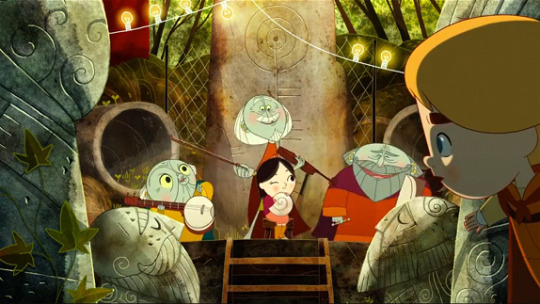
All throughout Song of the Sea we see iconography of modern Ireland. Conor drinks a pint of Guinness (unlabelled but unmistakable), the front of the pub he sits in is decorated in proto-typical Irish pub fashion. On the wall in Granny's house sits proudly a picture of Jesus with the Sacred Heart lamp as she warbles along to the classic Irish children's song, 'Báidín Fheilim��'. Ben and Saoirse take refuge in a shrine to a holy well with a rag tree outside that is bursting with religious iconography as well as a toy sheep. Symbols that are as much a part of the national identity as those pre-historic and mythological ones. There are also references to the assimilation of pop culture outside of Ireland in a Lyle's Golden Syrup tin, the Rolling Stones poster on Conor's old bedroom door and Ben's 3-D glasses and cape, an emulation of a superhero costume. These images are, ultimately, harmless but have overtaken their native counterparts. Although we see statues of the Sídhe in the background, these are not shrines but detritus, and they lie forgotten, covered in plants and moss, in the company of bags of rubbish and old televisions. The diminishing of one era of Ireland's history to make way for a newer more powerful and modern identity is just one kind of loss that is portrayed in Song of the Sea, but each character experiences their own version throughout. The loss of Bronach that has affected Ben and Conor; the potential loss of Saoirse as she grows sicker; the loss of Mac Lir that drove Macha to such despair she literally bottled her emotions and those of others until they turned to stone. All of this comes to a climax at the end of the film when these tragedies are laid bare. As in Wolfwalkers the greater connotations of this theme are presented on a smaller scale: Ben and Conor's pain by the loss of Bronach.
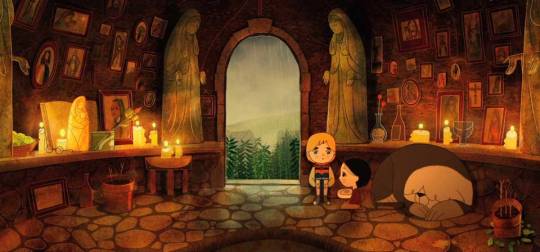
Ben and Conor are representative of the human world and so suffer her absence more visibly than Saoirse who approaches her mother's world with curiosity and ease. In contrast, Ben, although he misses Bronach, rejects the sea (her home and symbolic identity) and his sister, a physical as well as spiritual reminder of what's been taken away from him. He turns his back on his past as much as he mourns its loss. We see it less obviously in Conor who wallows in his own memories and grief and tunes out Ben's references to his mother "It's as though I've been asleep all these years. I'm so sorry." Ben's grief is more expressive compared to the inwardly focused Conor and even towards the end of the film when Ben is trying to help Saoirse, Conor brushes over his insistence that only her selkie coat can save her. It's only when Saoirse is finally wearing the coat and wakes up from her sickness that he finally engages with Ben on the subject of Bronach, "She's a selkie, isn't she? Like Mam." "Yeah." (Which looks like a weak conversation written down but it's the happy smile on his face and the emotion in his voice that give the single word weight). "Please don't take her from us." During the film's final sequence, when Saoirse sings her song and wakens the sleeping Sídhe, Bronach returns but only to take Saoirse away. With tears in her eyes she begins to lead Saoirse along until Ben and Conor stop her, not forcefully but pleadingly, "she's all we have." All they have is Saoirse, all they have is a thread connecting them to Bronach's world and their memories of her.
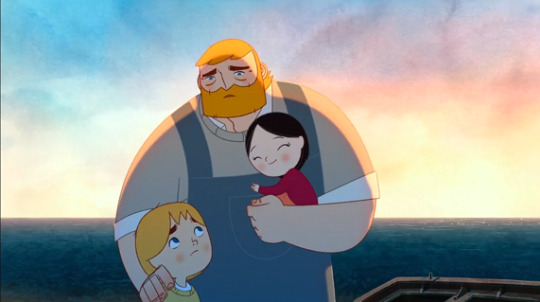
"All of my kind must leave tonight…" As the Sídhe are wakened by Saoirse's song we watch them rise joyfully to form a glowing processional in the sky as they make the journey across the sea to their home. This scene is so beautifully animated and so filled with a sense of magic and wonder that we are charmed into believing this is a good thing. The Sídhe are returned to their noble forms and going to their home "across the sea"; they fill the sky with a warm, mystical light, but they are taking that light and their magic with them. As Bronach quotes in the film's prologue, "Come away, o human child, to the waters and the wild, with a fairy, hand in hand, for the world's more full of weeping than you can understand." This is a world that can no longer bear the force of two identities. Unlike The Secret of Kells where Brendan and Aisling were allowed to live alongside each other without compromising their beliefs or ways of living, Bronach, a spiritual being, is forced to leave, while Ben and Conor have no choice but to stay and Saoirse, who walks both worlds, is made to choose between them. Although this is a happy ending it is still being depicted on a personal level. On a grander scale, the country has lost something that isn't coming back and this is depicted as a relief for the ones leaving it behind. On the other hand, Saoirse's decision to remain shows that, in small pockets of the country, the magic remains.
It is fitting that Song of the Sea, as a representation of modern Ireland, draws on loss; Ireland has been experiencing loss on a grand scale for centuries. Although the march of progress is mostly positive, in some cases it has altered our respect and interest in the past. Today there is a nihilism attached to Irish heritage; the spirituality that is associated with airy fairy hippies dancing naked in a moonlit field; the language that is almost universally despised by every secondary student forced to grapple with the Tuiseal Ginideach; its disappearing and continually exploited ecological landscapes; traditions and tales that grow more twee and archaic with every tourist bus that passes by; the preservation of archaeological sites in frequent battle with the progress of industry. In the interest of leaving behind the worst of our past we are at risk of losing the best. The writer Manchán Mangan suggests that this desire to forget lies in the pain we feel when we consider our history. Some, like Conor, try to push all reference to this pain out of their lives, others, like Ben, divert their pain into misplaced anger. Mangan cites the Famine as a source of generational pain and its effect today on our use of the language, but really it can be attached to many events and periods of time, "English was the future; Irish would only bring suffering and death." This is a sentiment that carries through to this day; despite encouragement from schools, local councils and the government, Irish remains a least favourite subject for most people who dismiss it as unuseful for success in the wider world. By proxy, anything to do with the notion of "Irish", the language, history and culture, is old-fashioned (suffering and death) while success and the future lie outside of the country. Mangan goes on to suggest that only by confronting the pain of our past can we unlock an ability in ourselves to engage more fully with our identity, "We might stop blaming our failure to learn on teachers, or the education system, or Government policy, and realise that we have no difficulty learning any other subject…" Ben and Conor are given the opportunity to say goodbye to Bronach before she leaves, allowing them to carry on with their memories of her and the last strand of their connection to her as represented by Saoirse. More and more people today are looking to Ireland's past, ecology and language for whatever it is they need or want to find. It isn't necessary to convert to paganism and live on the shores of the Connemara coastline to achieve this connection, but actively disengaging from your past can only hurt more than it can help. In their respective stories Brendan does not compromise his beliefs but still builds a friendship with Aisling, while Robyn and Bill integrate fully into Médb and Moll's world. There is no right way to engage with this side of our history and identity, but in contrast to Ben and Conor, Brendan and Robyn have balanced and fulfilling relationships with their native counterparts - the threats to their world come from outside sources. Ben and Conor were stuck in their pain over Bronach's loss and it is only after getting to see her one last time that helped them to move on and heal. Conor tells Bronach that he still loves her, he will carry his love and memories of her forever; Ben lets Saoirse into his life and is able to move past his grief and fears of the sea. Here, the threat of loss and destruction in modern Ireland comes from within, and can only be treated by engaging with the past - its rich heritage and tragic history - and moving on with all of the wisdom and experience it provides.

#another late post because my laptop charger broke#cartoon saloon#the secret of kells#song of the sea#wolfwalkers#irish mythology#irish movies#animated movies#animated films#animation#essays#film analysis#movie analysis#i do go on and on don't i
25 notes
·
View notes
Text


Buckeye is a bit of a plant snob, I think. It makes sense in a way because she seems to be part plant, but the biliog are designed to grow psychite and have improved plant skill in their genetics, so... Maybe Buckeye just thinks Blackdragon's not pretty enough to work in her garden.
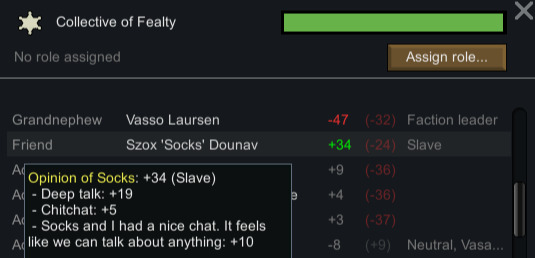

Our new Hussar colonist Curly only likes one of the cult members, but Socks considers him a rival.
Nineteen-year-old Curly is also, somehow, twenty-nine-year-old Vasso's granduncle.
And finally, it's time for the final colony tour of Loyalty's Meander before we set off to hopefully cover the last leg of the journey to the crashed ship!
Presenting... Loyalty's Meander!
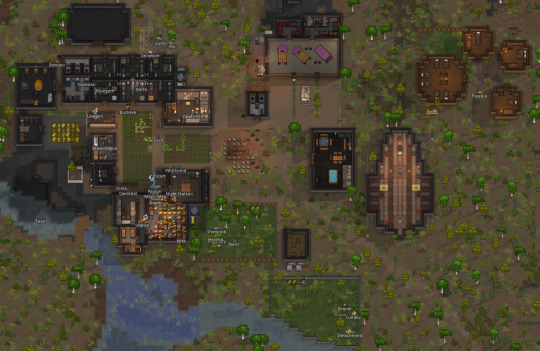
It's a quaint little settlement with not too much going on—aside from the giant murder church. I'm sure nearby settlements consider that more of a tourist attraction than a threat, though, right? Right?
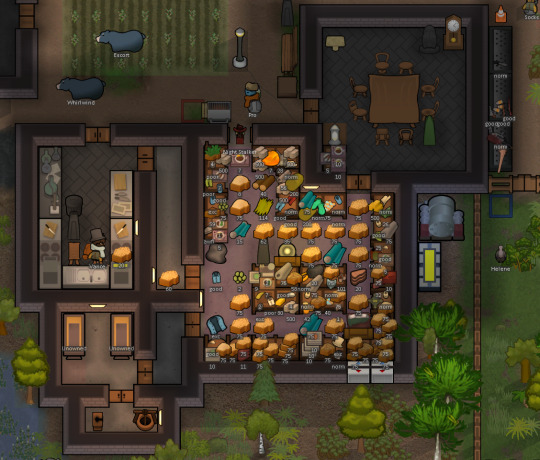
The central hub of the colony is the kitchen/dining space, with room for prisoners/spare food off towards the south.

There are some very productive fields and a stonecutting station set up in the centre of the colony.
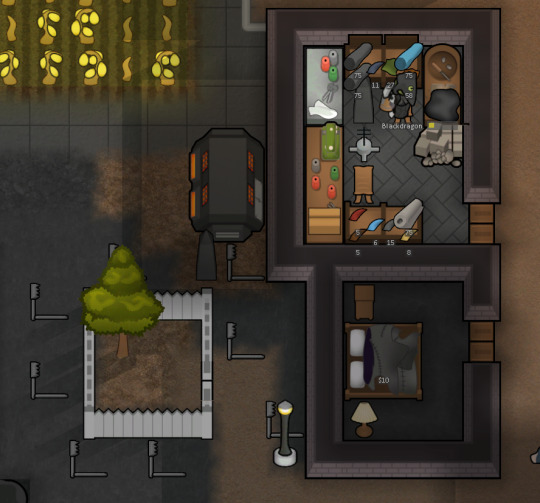
To the left is the saplingchild pen that recently saw the births of Magic Man and Buckeye's daughters, Blackthorn and Bluegum. We also have a tailorshop/art studio, and a guest bedroom.

Vance's room comes next. It was hastily constructed off to the side because he joined us later. Of course, we also have a dinosaur museum. I love dinosaur museums.

The main bedrooms are built in a sort of apartment-style structure, with a hospital and a bathroom at one end.
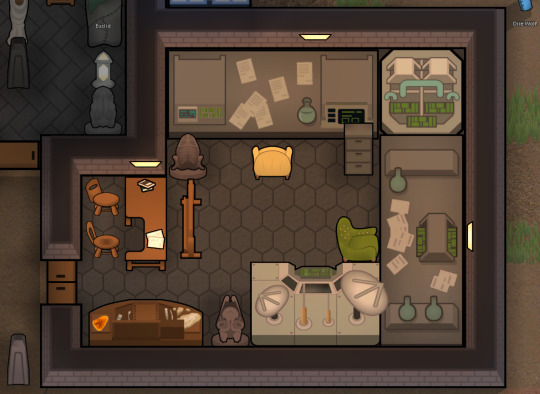
The laboratory is tacked on to the end of the apartment block, and it doubles as a classroom for the many children around the colony, though only Dire Wolf and Night Stalker ever used it because the others are still babies or toddlers, and Bella and Pro are adults now.
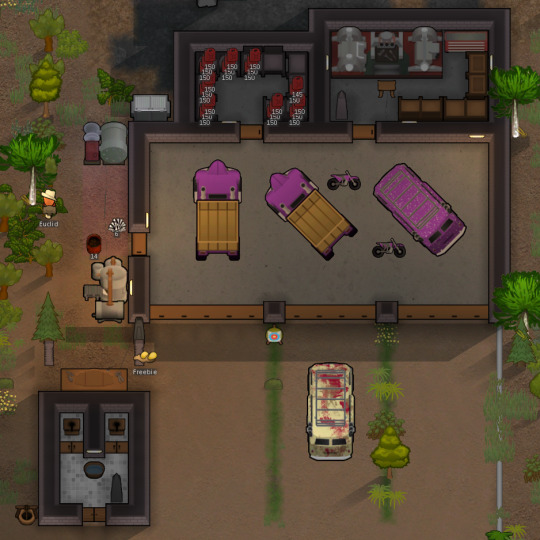
The garage, another bathroom, and our archery target for shooting recreation.

The rec room/fabrication room. This used to be our temple before some traders came by and sold us a prefab which became...

...The spookiest darn church you ever did see <3
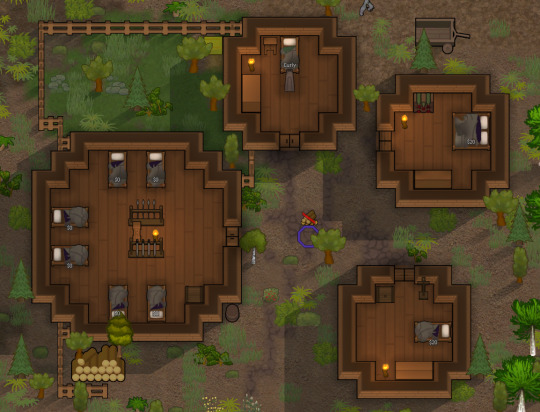
They also sold us a prefab for a "Viking Village," which we turned into a guest motel and Curly's bedroom, where he could do grumpy nonbeliever Hussar things away from the rest of the gang.
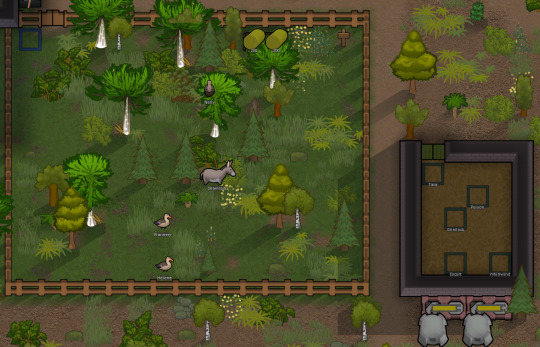
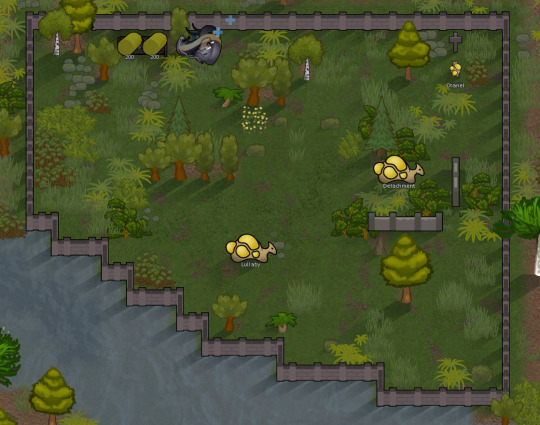
Last but not least are our animal pens and the barn. The boomalopes have a separate pen because they tend to explode when things don't go their way, and we can't risk losing Shamrock, the lucky donkey.
So there you have it! The end of Loyalty's Meander, and one step closer to escape <3
First | Next | Previous
#rimworld#gracie plays#The Children of Ecthuctu#art#my art#traditional art#rimworld art#unpolished art#poor Blackdragon and Curly#Maybe the two of them will be friends#though I doubt it#I hope we can make the marathon journey in one go#Then I can FINALLY get Anomaly#I've been trying to avoid spoilers but I WANNA PLAY IT SO BAD#how exciting~#have a fabulous day everyone! xoxo
38 notes
·
View notes
Text
On the topic of the HTTYD trilogy's misogyny...
Notice how Astrid is the only character in the Hooligan tribe with a realistic name, despite the film's opening narration stating that Vikings give their kids "hideous" names on purpose due to a cultural superstition. (The female lead in the books is named Camicazi, for comparison, and is also not a love interest.)
Notice how Astrid's character design is focused more on beauty standards than her actual personality. If you wanted to convey that a male character is tough and fierce and a skilled warrior, would you make them "petite"/slender with a round face and button nose? No? Why not? Because in this context that design serves to further gender roles, not her actual characterization.
The head of character animation (Simon Otto) said of Astrid in an art book: "We love that she is more of a lean, athletic beach volleyball player as opposed to the bulky, shot-putting type of Viking woman." Really think about the implications here. Why does the love interest have to be thin and conventionally attractive/feminine rather than buff and muscular as you'd expect for a Viking woman? Unlike Hiccup (and Camicazi who's a 4-foot-tall child for that matter) the fact she's physically smaller than what Vikings expect of a warrior is never addressed or relevant, because it's presumed that's just the natural default way for girls to look.
Speaking of which, notice how Astrid's character arc exclusively revolves around Hiccup in all three movies. She has almost no screen time to herself, no depth, and no meaningful character growth. She just starts out hating Hiccup because she's the popular girl and he's the awkward underdog, yet he later exceeds her in skill which she's understandably pissed and jealous about, but she gets over it instantly once he wins her over with a romantic dragon ride. (This follows a common and very obnoxious trope in many animated films.) From then on her role in the story begins and ends at "Hiccup's girlfriend".
Astrid sorta breaks gender roles by being a strong fighter, yes -- but that doesn't cancel out the other gendered problems with her characterization. Despite what many film studios apparently believe, physical strength and character strength are not synonymous, so if a female character is poorly written, making her good at fighting does not magically make her a "strong female character". Especially considering that due to extremely limited non-Hiccup-related screen time, Astrid doesn't get to actually use her strength very often. I mean, for fuck's sake, her role in the first film's climax is limited to being rescued by Hiccup/Toothless and then waiting on the shore and saying "Go..." to them. Sigh.
And just to make myself extra clear since media literacy is at an all-time low: pointing out misogyny does not mean that HTTYD is 100% Bad or that you're Bad for liking it or liking Astrid anyway. You can love a character while still acknowledging how she got screwed over by narrative sexism (just ask all the Bumble Warrior Cats fans here on Tumblr). And having serious issues like misogyny doesn't mean the films have nothing valuable to offer and to worth loving.
10 notes
·
View notes
Photo

Star Wars: Visions volume 2 will stream on Disney+ on May 4, 2023.
Volume 2 shorts:
Title: “Sith”
Studio: El Guiri
Writer-director: Rodrigo Blaas
Rodrigo Blaas is an Emmy Award®-winning director who has spent more than 20 years in animation. After co-founding Stromboli Animation in 1997, Blaas joined Blue Sky Studios in 2000, working on the feature film Ice Age, before transitioning to Pixar Animation Studios. There, he worked on such projects as Finding Nemo (2003), The Incredibles (2004), Ratatouille (2007), and Wall-E (2008) and on the Oscar®-nominated short film La Luna (2011). More recently, Blaas partnered with Guillermo del Toro to develop the award-winning series Trollhunters, served as creative director for Mikros Animation Paris and, in 2021, created El Guiri Studios in Madrid with his partner, Cecile Hokes. He also wrote and directed 2009’s award-winning short film Alma.
Title: “Screecher’s Reach”
Studio: Cartoon Saloon
Director: Paul Young
Paul Young is a co-founder of Cartoon Saloon, an IFTA winner and Oscar®, Emmy® and BAFTA nominee. He produced the animated features My Father’s Dragon, WolfWalkers, The Secret of Kells, Song of the Sea, and The Breadwinner as well as award-winning TV series including Puffin Rock, Dorg Van Dango, and Viking Skool.
Title: “In the Stars”
Studio: Punkrobot
Writer-director: Gabriel Osorio
Gabriel Osorio majored in Fine Arts at Universidad de Chile, later specializing in 3D animation. After working in commercials, movies and television series, he founded Punkrobot Studio. Since 2008, he has directed projects for children’s television including Flipos, Muelin y Perlita, Soccer Girls, and television spots. In 2016, his short film Bear Story became the first Latin American project to win an Oscar® in the animated short category.
Title: “I Am Your Mother”
Studio: Aardman
Director: Magdalena Osinska
Magdalena Osinska is an award-winning director who has been with Aardman for eight years. She has directed stop-motion, CGI, 2D and live-action commercials including Wallace & Gromit’s “The Great Sofa Caper” and “Share the Orange.” Osinska directed development of the children’s series Joyets and has also directed films including Spirits of the Piano and Zbigniev’s Cupboard. A graduate of the National Film and Television School in Beaconsfield, UK, as well as the Polish Film School in Lodz and Art College in Warsaw, Osinska is currently developing the feature film Jasia, based on her grandmother’s memories of WWII Poland.
Title: “Journey to the Dark Head”
Studio: Studio Mir
Director: Hyeong Geun Park
Rising star Hyeong Geun Park had already made a name for himself when he entered the Korean animation industry in 2017, thanks to his strong drawing and animation sensibilities. He has directed animation for dozens of cinematic game trailers and has since expanded into animated series, working on projects including Dota: Dragon’s Blood: Book 3 (2022) and Lookism (2022). Journey to the Dark Head is the first title he has executive produced from start to finish.
Title: “The Spy Dancer”
Studio: Studio La Cachette
Writer-director: Julien Chheng
Julien Chheng is CEO of Studio La Cachette, an Emmy Award®-winning French animation studio he co-founded in 2014 with fellow Gobelins school’s alumni Oussama Bouacheria and Ulysse Malassagne. Chheng was trained in visual development at Disney and has worked as a character animator on acclaimed 2D animated features The Rabbi’s Cat, Mune, and the Academy Award®-nominated Ernest and Celestine. In 2021, he won an Emmy Award® as animation executive producer of Genndy Tartakovsky’s Primal, for which he also served as animation supervisor. In 2022, Chheng directed with Jean-Christophe Roger the Cesar-nominated feature Ernest and Celestine: A Trip to Gibberitia.
Title: “The Bandits of Golak”
Studio: 88 Pictures
Director: Ishan Shukla
Ishan Shukla started his career as a CG artist in Singapore. For more than a decade, he spearheaded projects ranging from TV commercials to series and music videos. His 2016 animated short, "Schirkoa," was long listed for the Academy Awards® after receiving dozens of awards and playing at 120 international festivals, including SIGGRAPH Asia where it was named Best in Show. He then set up his own animation studio to work on adult-oriented animated feature films including a feature-length version of Schirkoa, set to hit festivals in summer 2023.
Title: “The Pit”
Studios: D’art Shtajio and Lucasfilm Ltd.
Writer-director-executive producer: LeAndre Thomas
Co-director: Justin Ridge
LeAndre Thomas is an award-winning writer and director from Oakland, Calif., whose most recent film won Best Director at the Pasadena International Film Festival. In addition to his independent films, Thomas is a part of the franchise studio team at Lucasfilm Ltd. where he has worked for more than 11 years being credited on recent titles such as Light & Magic, The Mandalorian, Obi-Wan Kenobi, Star Wars: Tales of the Jedi, and many more.
Justin Ridge executive produced the Emmy®-nominated series Star Wars Resistance. His credits also include Star Wars Rebels, Storks, The Cleveland Show, Star Wars: The Clone Wars, and Avatar: The Last Airbender.
Title: “Aau’s Song”
Studio: Triggerfish
Writer-directors: Nadia Darries and Daniel Clarke
Nadia Darries is a director, animator and co-founder of Goon Valley Animation, with an avocation for songwriting. Born in the Cape Flats in South Africa, Darries has worked on high-end animated film and motion design as an animator, project manager, creative director and director since 2015. Her experience includes animating at Triggerfish Animation Studios on the award-winning BBC films Stick Man, Revolting Rhymes, and Highway Rat.
Daniel Clarke is a Cape Town-based director and artist working in animation, film and illustration. He started his career in animation in 2008 at Triggerfish Animation Studios, where he has served as production designer, art director and director on projects such as the feature film Khumba, BBC’s Stick Man, and The Snail and the Whale. In 2018, along with James Clarke and Daniel Snaddon, he completed the graphic novel Kariba.
#Star Wars Visions#SW Visions#Star Wars#El Guiri#Cartoon Saloon#Punkrobot#Aardman Animations#Studio Mir#Studio La Cachette#88 Pictures#D’art Shtajio#Triggerfish#Lucasfilm#Disney#Disney Plus#Disney+#television#cartoon#shorts#animated shorts#anime#anime shorts
183 notes
·
View notes
Text
Test for Echo, Freud, and Elden Ring (Shadow of the Erdtree)
Thinking about how not all examples of fantasy stories come from books or film, sometimes they are found in song. Thinking about the lyricism of Canadian Progressive Rock band Rush.
If it wasn't obvious - the Shadowlands is a Freudian nightmare. The surrealism of Salvadore Dali was heavily influenced by Freudian psychoanalysis and the cocoon of the empyrean is staged to resemble Dali's work Geopoliticus Child Watching the Birth of the New Man.


Recently released Armored Core VI: Fires of Rubicon directly has an AC pilot named "Freud" whose emblem is a hand emerging from shadow holding a key (AC unit called "Locksmith").

And as it turns out, Neil Peart - lyricist for Rush - also was drawing inspirations from Freud while writing songs for Test for Echo (1996).
"I've always been curious about all religions, and the Totem idea came from the Freud book 'Totem And Taboo', which I ran across at the Chalet studio where we were working just in the bookshelf in the living room. I had been kind of rediscovering Freud by way of Jung and getting to understand the really deep stuff he was dealing with as opposed to some of the pop psychology that we were fed growing up, and I thought Totem And Taboo was such a beautiful title because it's what we fear and what we worship. Totem being what we worship and Taboo being what we fear. What a beautiful, embracing metaphor. At one time, the song Resist was called 'Taboo' because I wanted to have the two little set pieces of what we fear, and in 'Totem' I was just trying to appropriate all religions because that's what I found looking around at different religions and different systems, is that they all have something good. So I thought why not have them all? The 'Buddha smile' is a nice thing, and I'd like to have 12 Apostles...it's all great. It was really just a kind of tongue and cheek, all the good things of different religions." Neil Peart, Jam! Showbiz, October 16, 1996
The lyrics to the songs can be found here: https://www.rush.com/albums/test-for-echo/
It's a fantasy that people of all religions and esoteric beliefs would get together to craft their perfect god to fear and worship. Fortunately, Elden Ring is a fantasy. From the song "Totem", how many of the faith systems here can you spot represented somewhere in the game?:
I’ve got twelve disciples and a Buddha smile The Garden of Allah – Viking Valhalla A miracle once in a while I’ve got a pantheon of animals in a pagan soul Vishnu and Gaia – Aztec and Maya Dance around my totem pole I believe in what I see I believe in what I hear I believe that what I’m feeling Changes how the world appears Angels and demons dancing in my head Lunatics and monsters underneath my bed Media messiahs preying on my fears Pop culture prophets playing in my ears I’ve got celestial mechanics To synchronize my stars Seasonal migrations – daily variations World of the unlikely and bizarre I’ve got idols and icons, unspoken holy vows Thoughts to keep well-hidden – sacred and forbidden Free to browse among the holy cows That’s why I believe Angels and demons inside of me Saviors and Satans all around me Sweet chariot, swing low, coming for me
And then there's Resist, which has some Miquellian themes:
I can learn to resist Anything but temptation I can learn to co-exist With anything but pain I can learn to compromise Anything but my desires I can learn to get along With all the things I can’t explain I can learn to resist Anything but frustration I can learn to persist With anything but aiming low I can learn to close my eyes To anything but injustice I can learn to get along With all the things I don’t know
But neither of these songs were the tip off for why I thought to look more closely at this album. It was the Crucible Knights and Bloodhound Knights. They've always had the odd quirk of being named for geological periods. That's a lyric from the song Dog Years:
I’d rather be a tortoise from Galapagos Or a span of geological time Than be living in these dog years
Ironic that the tortoises in Elden Ring have no text option allowing them to be labelled appropriately, so the community has decreed them "dog".
There are other songs from this album that I can see represented in Elden Ring. The title song Test for Echo is about how people yearn for connection, but what the mass media landscape delivers is sensationalism and acts of violence around the world. In 30 years this hasn't really improved. A picture of an inunnguaq was selected for the album cover from fascination for the way that the simple stone structure provides evidence of the existence of other humans having travelled before through a desolate landscape. And as I have mentioned before, Radagon's story has hints of Narcissus and Echo.

This is bookended by the final song on the album Carve Away the Stone. The song suggests that like the Greek Sisyphus, all people are eternally rolling their own stones up a hill in the form of emotional baggage or other trauma. But people aren't static like a character from a story - they don't need to carry that weight forever. If you have the opportunity to shape your own destiny, why not take it? This would be related to the way that both Marika and Radagon appear to be carved of stone.
There's also the largely instrumental song that is second to last on the album and titled Limbo. It's implied to be vampire themed by one of the few vocal cut-ins being in a goofy vampire voice ("Whatever happened to my Transylvania twist?"). So like, Messmer the Impaler in the limbo-coded Shadowlands. His allusions to vampirism firstly being an epithet invoking Vlad the Impaler and also he has only false/closed eyes so he can't self reflect (one of the superstitions of vampires being that their reflection won't show up in a mirror because the mirrors in those days were polished silver). The archetype of the vampire in the Shadow is Jungian stuff and like I said - Neil Peart was thinking about depth psychology while writing this album.
For the rest of the songs the potential connections are more vague ("Time and motion / Flesh and blood and fire / Lives connect in webs of gold and razor wire" - Time and Motion) ("Gravity and distance / Change the passage of light / Gravity and distance / Change the color of right" - The Color of Right).
This isn't the only Rush album that I find possibly to have had some influence on the Radagon/Miquella/Mohg portion of Elden Ring. There's also the album 2112 (1976) back in Rush's earlier fantasy/sci-fi era, which introduces the Priests of the Temples of Syrinx - a kind of thought police represented by a red star - and mentions twin moons being in the sky. It was Rush's breakthrough album in America, followed the next year by A Farewell to Kings (1977), for which the notable songs include A Farewell to Kings, Xanadu, and Closer to the Heart. Also the album cover shows a puppet king slumped on a throne in front of a crumbling building. But again like with Test for Echo, one could imagine how all songs on the album might be combined to create an overall sense of time period.


I'm not making a case for FromSoft promoting Freudian pseudopsychology, for the record. All this psychoanalysis stuff is in the Shadowlands and nobody in the Lands Between cares about what's in the Shadowlands. It's in the past, dead and buried. You can no more decide the course of the future by replicating the past than you can create a sustainable global economy by learning economics through playing Elden Ring.
#elden ring#shadow of the erdtree#the circumstances in which Vapor Trails (2002) was written are super tragic and not something I'm willing to get into right now#even if I do find it extremely relevant to discussion of Rush and Elden Ring#But I will say that “A Peaceable Kingdom” has a tarot metaphor which I've mentioned before for Elden Ring#Thinking about how the nomad merchants are the musicians and their huts are covered in maple leaves and the Canada flag is a maple leaf#Very silly#I went to see Rush in concert with my fam when they did a hometown show in 2013 for the final album Clockwork Angels#Hilariously my favourite Rush song is YYZ which has no lyrics and is a homage to an airport
6 notes
·
View notes
Note
hi, first time i see bakerix, im think bread viking look weird, it is weird?
I think they outsourced the Bakerix episode to one of the cheaper animation studios, yeah
#to person sending these asks#you can just comment on one of my posts to have these conversations#it's okay I promise I'm not that scary 😭#bugoutreviewgirlie#miraculous ladybug#ask#answered
3 notes
·
View notes